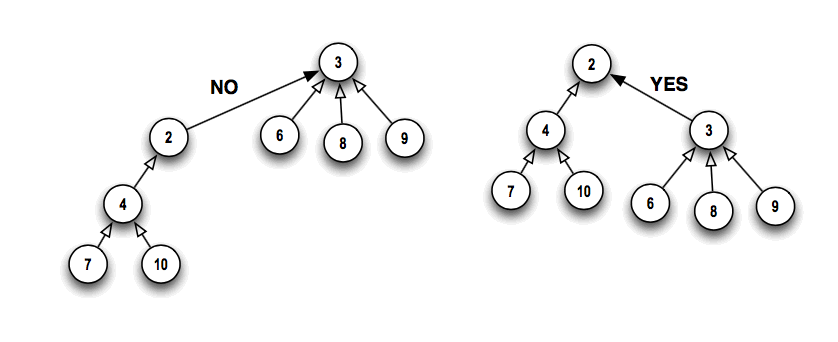(rev. Feb 14, 2021)
[2020/03/02: added some more detail to the proof of Theorem 5.9.1]
The "Log Height" Theorem
for Trees Representing Disjoint Sets

- When merging, what if we insist on making the lower height tree
the subtree of the greater height tree? Then if the two heights
h1 and h2 are not equal, the height of the new tree
will be max{h1, h2}, else the new height will be
h1 + 1.
- The figure above is an example. On the right, the new tree is no higher than the
taller of the two subtrees that were joined. On the left, the new tree is higher
than both subtrees.
- Theorem 5.9.1(version b) Using the merging technique described above,
after an arbitrary sequence of merge operations starting from
the initial situation (N singletons), a tree containing k nodes
has (edge) height less than or equal to log(k). (Logs in this discussion are all
base-2.)
- PROOF We proceed by induction on k. If k=1, the edge height is 0,
and also log(k)=log(1)=0. So 0=height-of-tree ≤ log(k)=0 is true for a tree
with k=1 node. That is our base case.
Suppose now that the theorem is true for all positive integers j, such that
1 ≤ j ≤ k-1, where k>1. Suppose that we proceed with building up
trees using the merging technique described, and suppose we get to the point
where a tree with k nodes has been formed by merging a tree with y nodes
and a tree with z nodes. Assume the variable names y, z were chosen
so that y ≤ z. Note the following observations:
- k = y+z.
- Neither y nor z is zero, because in the process we defined, the trees
that are merged are never empty - they all start out containing
a single node, and they can only grow larger.
- Both y and z are less than k. This follows from the facts that neither
y nor z is 0 and that y+z adds up to k.
- y≤k/2 If not, then both y and z would be greater than k/2, which would
make their sum, k, greater than (k/2)+(k/2)=k. Obviously k>k is false.
Let hy, hz, and hk be the respective (edge)
heights of the three trees.
Case #1: If hy ≠ hz,
then hk=maximum{hy, hz}. In particular,
hk = hy or hk = hz.
Using the inductive hypothesis, we may assume that hy ≤ log(y)
and hz ≤ log(z).
Therefore, one or the other of the following statements is true
- hk = hy ≤ log(y) ≤ maximum{log(y), log(z)}
- hk = hz ≤ log(z) ≤ maximum{log(y), log(z)}
In either case, it follows that hk ≤ maximum{log(y), log(z)}.
Also, because log is an increasing function, and
because y<k, and z<k, maximum{log(y), log(z)} < log(k).
Therefore, if hy ≠ hz,
hk ≤ log(k).
Case #2: If hy = hz,
then hk = 1 + hy
≤ 1 + log(y). Since y≤k/2, 1 + log(y) ≤
1 + log(k/2) = 1 + log(k) - 1 = log(k). It follows from this that
hk ≤ log(k).
We've proved the inductive step for all cases, so this completes the proof.

